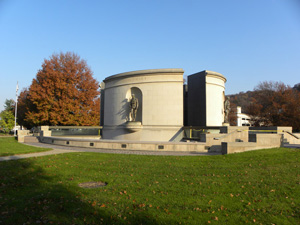

Remember...
James Edward Findley
1923-1944
"Semper Fi!"
Marine Corps motto
 |
Remember...James Edward Findley
|
James Edward Findley was born on June 5, 1923, in Clarksburg, West Virginia, to Elijah Franklin (known as Frank) Findley and Mary Lelia (known as Lelia) Hansford Findley. According to the 1930 Federal Census, the family lived in Clarksburg, where Mr. Findley worked in a retail grocery store as a salesman. At home were James and his sister Pauline. Their brother Paul was no longer living there. In 1932, Mr. Findley died. In 1940, Lelia, Pauline, and James were still living together. Pauline was, then, a public school teacher. James attended Washington Irving High School. In 1941, Mrs. Findley died of Hodgkin's disease.
By 1942, James had graduated from high school and was employed by National Carbon Company (later a division of Union Carbide). He registered for military service on June 30, 1942. At that time, he was living with his sister.
James Findley enlisted in the U.S. Marine Corps on September 18, 1942. He took basic training at Parris Island, South Carolina, and also trained in New River, North Carolina. He graduated from the Marine Armament School in Philadelphia, Pennsylvania. ("Bodies of Three County War Dead Enroute to City," Clarksburg Daily Telegram, 29 October 1947.) He was then placed with Company E, 2nd Battalion, 22nd Regiment, 22nd Marine Infantry. The 22nd was deployed to the Pacific Theater.
A summary of activity during those six days of appears in a Stamford Historical Society article:
Naval bombardment of Eniwetok began 17 February, while the 22nd Marine Regiment, commanded by Col. John T. Walker, landed on Engebi Island, on the north side of the atoll, a day later. Engebi was secured within six hours with only light resistance offered. More than 1200 Japanese, Koreans and Okinawans were on Engebi, only 19 surrendered. Captured information suggested a similarly light defense on Eniwetok, so the bombardment on the island was short prior to the landing of the 1st and 3rd Batallions [sic] of the 106th Infantry Regiment on February 19th. Unfortunately the Japanese were well entrenched on the island and the U.S. advance was halted under heavy fire. The island was not secured until 21 February. More than 800 Japanese defenders died on Eniwetok alone, compared with 37 U.S. troops. On Parry Island no assumptions of light Japanese defense were made, but instead the battleships Tennessee and Pennsylvania and other ships shelled the island with more than 900 tons of explosives. Battleships moved to within 1500 yards of the shore to fire on Japanese positions. When the 22nd Marines landed on 22 February, resistance was light and by 23 February the whole atoll had fallen to the American forces.By the end of the battle the Americans had suffered 262 killed, 77 missing and 757 wounded. The Japanese lost 2677 killed, 16 Japanese captured and 48 laborers captured. ("The Battle of Eniwetok," Pride and Patriotism: Stamford's Role in World War II, accessed 24 November 2021, https://www.stamfordhistory.org/ww2_eniwetok.htmv.)
The objective of taking the islands so that the Allied force would have an airfield and harbor to support attacks against the Mariana Islands to the northeast was achieved.
James Findley was first buried on Japtan Island. In 1947, he was disinterred and removed to Clarksburg. He was buried in Elkview Cemetery, not far from the family home, on November 1, 1947.
James Findley's brother Paul was also a World War II veteran, having served in the Army from 1942 to 1945.
Article prepared by Cynthia Mullens
December 2021

West Virginia Archives and History welcomes any additional information that can be provided about these veterans, including photographs, family names, letters and other relevant personal history.